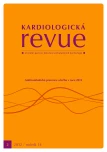Anticoagulant therapy and atrial fibrillation
Authors:
R. Lábrová; J. Špinar
Authors‘ workplace:
Interní kardiologická klinika LF MU a FN Brno
Published in:
Kardiol Rev Int Med 2012, 14(2): 79-86
Overview
Atrial fibrillation is the most frequent supraventricular arrythmia and is associated with increased morbidity and mortality. Patients with any form of atrial fibrillation have significantly higher risk of stroke and systemic embolism. Therefore, anticoagulation therapy is needed to prevent and treat cardioembolic events in such patients. According to updated 2010 European Guidelines for Diagnosis and Treatment of atrial fibrillation, the patients should be stratified and indicated to anticoagulation therapy based on their risk of stroke using the CHA2DS2-VASc scoring system but with regards to their bleeding risk as calculated by the HAS-BLED score. Novel anticoagulant agents that interfere with the coagulation cascade at different levels and have markable advantages over vitamin K antagonist – warfarin have been developed. These include a direct thrombin inhibitor dabigatran (RE-LY study), factor Xa inhibitors rivaroxaban (Rocket AF study) and apixaban (AVERROES, ARISTOTLE studies). Another anti-Xa agent edoxaban is being tested in a large clinical trial (ENGAGE).
Keywords:
atrial fibrillation – CHA2DS2-VASc-VASc score – warfarin – novel anticoagulants – dabigatran – apixaban – rivaroxaban – edoxaban
Sources
1. Go AS, Hylek EM, Phillips KA et al. Prevalence of diagnosed atrial fibrillation in adults. National implications for rhythm management and stroke prevention: The Anticoagulation and Risk Factors in Atrial Fibrillation (ATRIA) Study. JAMA 2001; 285 : 2370–2375.
2. Lábrová R. Epidemiologie fibrilace síní. Kardiofórum 2007; 5 : 6–10.
3. Camm AJ, Kirchhof P, Lip GY et al. European Heart Rhythm Association, European Association for Cardio-Thoracic Surgery. Guidelines for the management of atrial fibrillation: the Task Force for the Management of Atrial Fibrillation of the European Society of Cardiology (ESC). Eur Heart J 2010; 31 : 2369–2429.
4. Čihák R, Heinz P, Haman L et al. Fibrilace síní doporučený diagnostický a léčebný postup České kardiologické společnosti vypracovaný Pracovní skupinou arytmie a trvalé kardiostimulace. Cor Vasa 2011; 53 (Suppl 1): 27–52.
5. Hart RG, Benavente O, McBride R et al. Antithrombotic therapy to prevent stroke in patients with atrial fibrillation: a meta-analysis. Ann Intern Med 1999; 131 : 492–501.
6. Lip GY, Nieuwlaat R, Pisters R et al. Refining clinical risk stratification for predicting stroke and thrombembolism in atrial fibrillation using a novel risk factor-based approach: the Euro Heart Survey on atrial fibrillation. Chest 2010; 137 : 263–272.
7. Pisters R, Lane DA, Nieuwlaat R et al. A novel userfriendly score (HAS-BLED) to assess one-year risk of major bleeding in patients with atrial fibrillation: The Euro Heart Survey. Chest 2010; 138 : 1093–1100.
8. Nabauer M, Gerth A, Limbourg T et al. The Registry of the German Competence NETwork on Atrial Fibrillation: patient characteristics and initial management. Europace 2009; 11 : 423–434.
9. Conolly SJ, Pogue J, Hart RG et al. ACTIVE Investigators. Effect of clopidogrel added to aspirin in patients with atrial fibrillation. N Engl J Med 2009; 360 : 2066–2078.
10. Conolly SJ, Pogue J, Hart RG et al. ACTIVE Writing Group of the ACTIVE Investigators. Clopidogrel plus aspirin versus oral anticoagulation for atrial fibrillation in the Atrial fibrillation Clopidogrel Trial with Irbesartan for prevention of Vascular Events (ACTIVE W): a randomised controlled trial. Lancet 2006; 367 : 1903–1912.
11. Ezekowitz MD, Conolly S, Pareth A et al. Rationale and design of RE-LY: randomized evaluation of long-term anticoagulant therapy, warfarin, compared with dabigatran. Am Heart J 2009; 157 : 805–810.
12. SPC přípravku Pradaxa 110 a 150mg, SÚKL Praha, 2011.
13. Connolly SJ, Ezekowitz MD, Yusuf S et al. RE-LY Steering Committee and Investigators. Dabigatran versus warfarin in patients with atrial fibrillation. N Engl J Med 2009; 361 : 1139–1151.
14. ROCKET AF Study Investigators. Rivaroxaban once daily, oral, direct factor Xa inhibition compared with vitamin K antagonism for prevention of stroke and Embolism Trial in Atrial Fibrillation: rationale and design of the ROCKET AF study. Am Heart J 2010; 159 : 340–347.
15. Eikelboom JW, O’Donnell M, Yusuf S et al. Rationale and design of AVERROES: apixaban versus acetylsalicylic acid to prevent stroke in atrial fibrillation patients who have failed or are unsuitable for vitamin K antagonist treatment. Am Heart J 2010; 159 : 348–353.
16. Granger CB, Alexander JH, McMurray JJ et al. ARISTOTLE Committees and Investigators. Apixaban versus warfarin in patients with atrial fibrillation. N Engl J Med 2011; 365 : 981–992.
17. Weitz JI, Crowther MA. New anticoagulants: current status and future potential. Am J Cardiovasc Drugs 2003; 3 : 201–209.
18. Weitz JI, Hirsh J, Samama MM. American College of Chest Physicians. New antithrombotic drugs: American College of Chest Physicians Evidence-Based Clinical Practice Guidelines (8th ed.). Chest 2008; 133 : 234S–256S.
19. Connolly SJ, Ezekowitz MD, Yusuf S et al. Randomized Evaluation of Long-Term Anticoagulation Therapy Investigators. Newly identified events in the RE-LY trial. N Engl J Med 2010; 363 : 1875–1876.
Labels
Paediatric cardiology Internal medicine Cardiac surgery CardiologyArticle was published in
Cardiology Review

2012 Issue 2
Most read in this issue
- Antiaggregating and anticoagulant therapy – basic principles
- Anticoagulant therapy and atrial fibrillation
- Where is a step in the current development of drugs that affect blood clotting?
- Current guidelines for antiplatelet therapy in neurology
